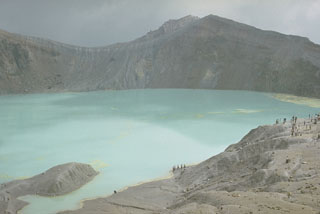Report on Kusatsu-Shiranesan (Japan) — January 1984
Scientific Event Alert Network Bulletin, vol. 9, no. 1 (January 1984)
Managing Editor: Lindsay McClelland.
Kusatsu-Shiranesan (Japan) 1983 activity summarized
Please cite this report as:
Global Volcanism Program, 1984. Report on Kusatsu-Shiranesan (Japan) (McClelland, L., ed.). Scientific Event Alert Network Bulletin, 9:1. Smithsonian Institution. https://doi.org/10.5479/si.GVP.SEAN198401-283120
Kusatsu-Shiranesan
Japan
36.618°N, 138.528°E; summit elev. 2165 m
All times are local (unless otherwise noted)
1983 activity is summarized in table 1; locations are on figure 1.
Table 1. Seismic activity at Kusatsu-Shirane, 1983. Courtesy of JMA.
| Month | Discrete Seismic Events | Continuous Tremor | Remarks |
| Jan 1983 | Observed swarms | Observed | Rumbling at the summit. |
| Mar 1983 | Observed swarms | -- | Increased fumarolic activity at Pit No. 2. |
| Apr 1983 | -- | Observed | White plumes from Pits No. 2, No. 7, and a fumarole on the N inner wall of Yugama; N edge of frozen Yugama lake melted. |
| Jun 1983 | Observed swarms | -- | -- |
| Jul 1983 | Observed swarms | Almost at noise level | Small eruption at Pit No. 6, NW wall of Yugama, on 26 July; small amount of ash. |
| Nov 1983 | Observed swarms | Observed during eruptive activity | Explosive eruption at NW inner wall of Yugama and at Karagama on 13 Nov; a larger amount of ejecta. |
| Dec 1983 | Observed swarms | Observed during eruptive activity | -- |
Further Reference. The 1982-1983 eruptions of Kusatsu-Shirane volcano, in XIX IUGG General Assembly, 1987, Report on volcanic activities and volcanological studies in Japan for the period from 1983 to 1986, p. 5-8.
Geological Summary. The Kusatsu-Shiranesan complex, located immediately north of Asama volcano, consists of a series of overlapping pyroclastic cones and three crater lakes. The andesitic-to-dacitic volcano was formed in three eruptive stages beginning in the early to mid-Pleistocene. The Pleistocene Oshi pyroclastic flow produced extensive welded tuffs and non-welded pumice that covers much of the E, S, and SW flanks. The latest eruptive stage began about 14,000 years ago. Historical eruptions have consisted of phreatic explosions from the acidic crater lakes or their margins. Fumaroles and hot springs that dot the flanks have strongly acidified many rivers draining from the volcano. The crater was the site of active sulfur mining for many years during the 19th and 20th centuries.
Information Contacts: JMA, Tokyo.

